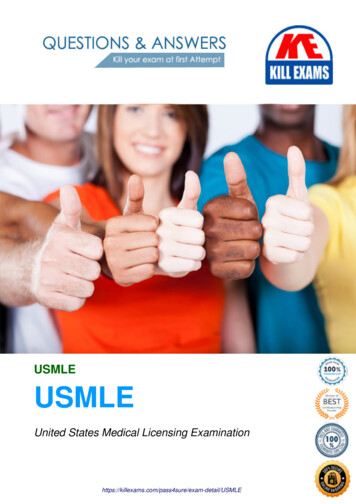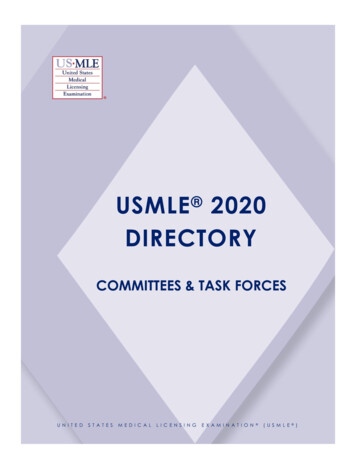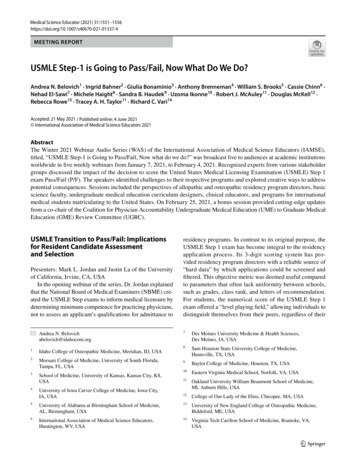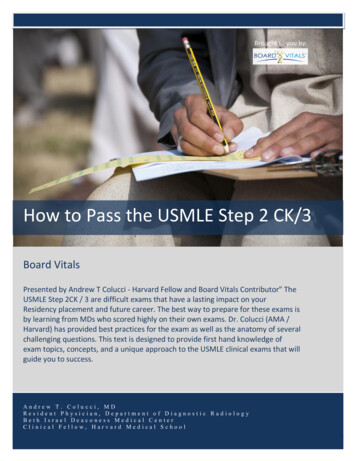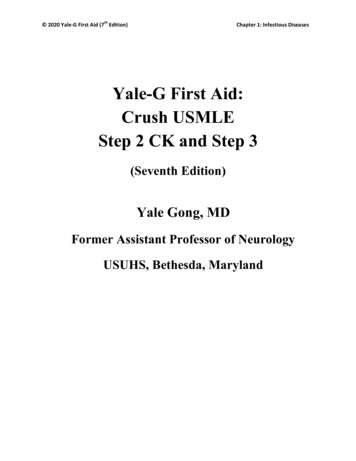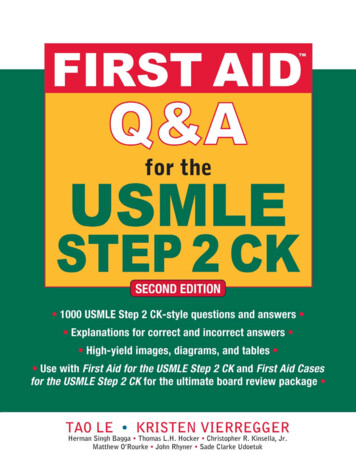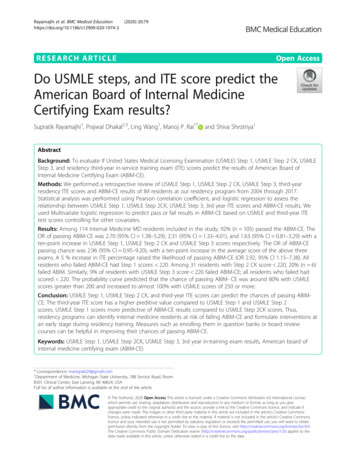
Transcription
Rayamajhi et al. BMC Medical (2020) 20:79RESEARCH ARTICLEOpen AccessDo USMLE steps, and ITE score predict theAmerican Board of Internal MedicineCertifying Exam results?Supratik Rayamajhi1, Prajwal Dhakal2,3, Ling Wang1, Manoj P. Rai1*and Shiva Shrotriya1AbstractBackground: To evaluate if United States Medical Licensing Examination (USMLE) Step 1, USMLE Step 2 CK, USMLEStep 3, and residency third-year in-service training exam (ITE) scores predict the results of American Board ofInternal Medicine Certifying Exam (ABIM-CE).Methods: We performed a retrospective review of USMLE Step 1, USMLE Step 2 CK, USMLE Step 3, third-yearresidency ITE scores and ABIM-CE results of IM residents at our residency program from 2004 through 2017.Statistical analysis was perfrormed using Pearson correlation coefficient, and logistic regression to assess therelationship between USMLE Step 1, USMLE Step 2CK, USMLE Step 3, 3rd year ITE scores and ABIM-CE results. Weused Multivariate logistic regression to predict pass or fail results in ABIM-CE based on USMLE and third-year ITEtest scores controlling for other covariates.Results: Among 114 Internal Medicine MD residents included in the study, 92% (n 105) passed the ABIM-CE. TheOR of passing ABIM-CE was 2.70 (95% CI 1.38–5.29), 2.31 (95% CI 1.33–4.01), and 1.63 (95% CI 0.81–3.29) with aten-point increase in USMLE Step 1, USMLE Step 2 CK and USMLE Step 3 scores respectively. The OR of ABIM-CEpassing chance was 2.96 (95% CI 0.95–9.20), with a ten-point increase in the average score of the above threeexams. A 5 % increase in ITE percentage raised the likelihood of passing ABIM-CE (OR 2.92, 95% CI 1.15–7.38). Allresidents who failed ABIM-CE had Step 1 scores 220. Among 31 residents with Step 2 CK score 220, 20% (n 6)failed ABIM. Similarly, 9% of residents with USMLE Step 3 score 220 failed ABIM-CE; all residents who failed hadscored 220. The probability curve predicted that the chance of passing ABIM- CE was around 80% with USMLEscores greater than 200 and increased to almost 100% with USMLE scores of 250 or more.Conclusion: USMLE Step 1, USMLE Step 2 CK, and third-year ITE scores can predict the chances of passing ABIMCE. The third-year ITE score has a higher preditive value compared to USMLE Step 1 and USMLE Step 2scores. USMLE Step 1 scores more predictive of ABIM-CE results compared to USMLE Step 2CK scores. Thus,residency programs can identify internal medicine residents at risk of failing ABIM-CE and formulate interventions atan early stage during residency training. Measures such as enrolling them in question banks or board reviewcourses can be helpful in improving their chances of passing ABIM-CE.Keywords: USMLE Step 1, USMLE Step 2CK, USMLE Step 3, 3rd year in-training exam results, American board ofinternal medicine certifying exam (ABIM-CE)* Correspondence: manojrai029@gmail.com1Department of Medicine, Michigan State University, 788 Service Road, RoomB301 Clinical Center, East Lansing, MI 48824, USAFull list of author information is available at the end of the article The Author(s). 2020 Open Access This article is licensed under a Creative Commons Attribution 4.0 International License,which permits use, sharing, adaptation, distribution and reproduction in any medium or format, as long as you giveappropriate credit to the original author(s) and the source, provide a link to the Creative Commons licence, and indicate ifchanges were made. The images or other third party material in this article are included in the article's Creative Commonslicence, unless indicated otherwise in a credit line to the material. If material is not included in the article's Creative Commonslicence and your intended use is not permitted by statutory regulation or exceeds the permitted use, you will need to obtainpermission directly from the copyright holder. To view a copy of this licence, visit http://creativecommons.org/licenses/by/4.0/.The Creative Commons Public Domain Dedication waiver ) applies to thedata made available in this article, unless otherwise stated in a credit line to the data.
Rayamajhi et al. BMC Medical Education(2020) 20:79BackgroundThe assessment of a resident's competency during training is a complex process. Residency programs perform atwice yearly evaluation of the six core competenciesidentified by Accreditation Council for Graduate Medical Education (ACGME) to improve the overall performance of the residents [1]. American Board ofInternal Medicine (ABIM) uses various factors to testthe skills of the physicians and their ability to deliverhigh-quality care. The factors include fulfillment of thegraduate medical education training requirements, demonstration of clinical competence in patient care, andpassing the American Board of Internal Medicine Certifying Exam (ABIM-CE) [2]. ABIM-CE is administeredonce every year for residents who complete their training.ABIM-CE results are important for both the residentsand their residency programs. In order for the residencyprograms to maintain their ACGME accreditation,ACGME requires a 80% pass rate in ABIM-CE from thefirst-time takers of the exam in the latest three-yearperiod [3].Various tools are used by IM residency programs toselect candidates likely to perform well in ABIMCE to maintain ABIM-CE success rate. United StatesMedical Licensing Examination (USMLE) scores arecommonly used by residency programs to screen residency applicants [4–6]. During the residency training,the annual in-service training exam (ITE) serves as atool to assess the medical knowledge of the residents. Anational standardized ITE was developed for various specialties, including IM, to provide feedback to the residents and the training program [7]. By assessing theknowledge gap (the deficit in the knowledge that can beimproved to achieve better scores), ITE exams allow theresidents to understand the areas in need for improvement. Also, the ITE exam score is used by the trainingprograms to evaluate the residents readiness for ABIMCE and the residents ability pass ABIM-CE [7].Previously, several studies have reported variable degrees of correlation between USMLE and ITE scores [5,6, 8, 9]. A few studies reported an association betweenUSMLE scores and IM-ITE performance [10, 11].A modest correlation between failing USMLE Step 1and scoring at the bottom quartile in ITE scores withrisk of failing ABIM-CE was reported by Kay et al. [12].In our study, we analyze whether USMLE Step 1,USMLE Step 2 CK, USMLE Step 3, and residency thirdyear ITE scores correlated with the results of ABIMCE.MethodsStudy sample and characteristicsAll residents enrolled in our IM residency training program from 2004 through 2017 were included. ThePage 2 of 8collected data included gender; type of degree (MD versus DO); medical school country (American MedicalGraduate [AMG] versus International Medical Graduate[IMG]); scores in USMLE Step 1, USMLE Step 2 CK,USMLE Step 3, 3rd year ITE results; gap (number ofyears) between graduation from medical school and startof residency (referred to as ‘the gap’); and ABIM-CE results (Pass versus Fail). The number of osteopathic residents (DO) was considerably less than allopathicresidents (MD), and they had taken COMLEX exams instead of USMLE Steps so DO residents were excluded.Also, the MD residents without complete data were excluded. Thus, after excluding DO residents (n 18) andMD residents with incomplete data (n 9), theremaining MD residents were included in the analysis.Scores of ITE from the third year of residency, theexam closest to ABIM-CE in the timeline, were used inour analysis because third-year ITE scores reflect thereadiness of the residents to take ABIM-CE.Statistical analysisWe presented all continuous data as mean (SD), and categorical data as N(%), Statistical analyses were based onscaled scores. We used the Pearson correlation coefficient to assess the correlation between USMLE Step 1,USMLE Step 2 CK, USMLE Step 3, and third-year ITEscores. We performed logistic regression to evaluate therelationship between various scores separately and passor fail results in ABIM-CE. Also, we performed multivariate logistic regression to examine the relationshipbetween the scores and the ABIM-CE results controllingfor other confounding variables such as gender, medicalschool country, the gap between medical school andresidency program. Significance was set at p 0.05. Weused SAS 9.4 software (SAS Institute Inc., Cary, NorthCarolina) to perform statistical analysis.Ethics approvalWe received an exemption from the approval of Michigan State University Human Research Protection Program – MSU institutional board review (IRB# 16029e). We did not obtain consent from individual graduates, the data is de-identified, and the ethics committeeapproved this procedure.ResultsWe included a total of 114 MD residents in the study;92% (n 105) passed the ABIM-CE. Table 1 shows thecharacteristics of the residents, along with their meanscores in different exams. Table 2 shows the meanUSMLE Step 1, USMLE Step 2CK, USMLE Step 3 and3rd year ITE scores of based on ABIM-CE results.All residents (n 9) who failed ABIM-CE scored 220in USMLE Step 1 which was 25% of total residents with
Rayamajhi et al. BMC Medical Education(2020) 20:79Page 3 of 8Table 1 Demographic characteristics and examination scoresGender (n, %)Female34 (29.8)Male80 (70.2)Medical School Country (n, %)United States or Canada17 (14.9)International97 (85.1)Gap between medical school graduation and start ofresidency (years, mean (range))3.1 (0–17)USMLE Scores (mean (SD))Step 1230 (19)Step 2230 (21)Step 3208 (13)Mean of Step 1, Step 2 and Step 3222 (14)Third-year ITE percentage (mean (SD))68 (7)ABIM-CE results (n, %)Pass105(92.1)Fail9 (7.9)USMLE Step 1 score of 220 (n 35). Among 31 residents with USMLE Step 2 CK score 220, 20% (n 6)failed ABIM whereas only 10% (n 3) with USMLE Step2 CK score 220 failed ABIM-CE. Similarly, 9% of residents with USMLE Step 3 score 220 failed ABIM-CE; allresidents who failed had scored 220.First, logistic regressions were employed to predictABIM-CE passing with USMLE Step 1, USMLE Step 2CK, USMLE Step 3, and ITE tests separately controllingfor gender, country of the medical school, and 1 year ofthe gap between medical school and the start of residency. There was a significant correlation of passingABIM-CE with 10 points increase in USMLE Step 1(Odds ratio [OR] 2.70; 95% Confidence Interval [CI]1.38–5.29) and 10 points increase in Step 2 CK (2.31;95% CI 1.33–4.01). However, a 10 points increase inStep 3 (OR 1.63; 95% CI 0.81–3.29) did not significantlypredict passing ABIM-CE. A 5% increase in ITE percentage increased the likelihood of passing ABIM-CE (OR3.89, 95% CI 1.68–8.98).Table 2 USMLE and ITE scores of residents who passed ABIMCE versus those who did notScores (Mean (SD))pvalueABIM-CE PassABIM-CE FailUSMLE Step 1231 (18)209 (12) 0.001USMLE Step 2233 (19)204 (19) 0.001USMLE Step 3208 (13)200 (6)0.07Third-year ITE69 (7)59 (6) 0.001ABIM-CE American Board of Internal Medicine- Certifying Exam, ITE In-TrainingExam, SD Standard Deviation, USMLE United States Medical Licensing ExamNext, we calculated the average of USMLE Step scoresand predicted the ABIM-CE pass result using the average Step scores. Table 3 shows the results from the analysis of maximum likelihood estimates. A 10 pointsincrease in average Step scores will lead to a higherchance of passing ABIM-CE tests (OR 2.96, 95% CI 0.95–9.20)) but not significantly at α 0.05 level. Therewas no relationship between ABIM-CE results and gender, the country of medical school (American medicalgraduate AMG vs. International medical graduate IMG). The increase in the gap (1 year) was not significantly associated with the chances of passing ABIM-CE(OR 0.82; 95% CI 0.364–1.06) (Table 3).The probability curve (with third year-ITE percentageand the gap set at mean values) predicted that the chanceof passing ABIM- CE was around 80% with USMLEscores higher than 200 and ABIM-CE passing chance increased to almost 100% with USMLE scores of 240 orhigher (Fig. 1). A ROC (receiver-operating characteristic)curve was computed to assess the accuracy of the model’sability to predict passing the ABIM-CE. The area underthe ROC curve was 0.945 (Fig. 2), which indicates that theprobability of our model will rank a randomly chosen“pass the board” higher than “not pass the board” is 0.945.We repeated the analysis using standardized USMLEstep scores and standardized ITE test scores with mean atzero and standard deviation (SD) at 1. One SD increase inUSMLE Step 1 lead to a significantly higher chance ofpassing ABIM-CE (OR 6.41, 95% CI 1.84–22.46) andone SD increase in USMLE Step 2 CK lead to a significantly higher chance of passing ABIM-CE (OR 5.62,95% CI 1.80–17.60). However, a 1 SD increase in USMLEStep 3 is not significantly associated with passing ABIMCE (OR 1.89, 95% CI 0.76–4.68). Table 4 shows the results with a 1 SD increase in average USMLE score andITE percentage increase after controlling for demographics. Our analysis also found that a 1 SD increase in theITE test leads to a higher chance of passing ABIM (OR 5.0, 95% CI 1.24–20.25). The results indicate that one SDchange in the ITE test has the most significant effect onincreasing the chance of passing the ABIM-CE.DiscussionOur analysis showed that USMLE Step 1, USMLE Step 2CK, USMLE Step 3, and third-year ITE scores have apredictive value in determining the chances of passingABIM-CE. Among them, ITE percentage is the mostpredictive, followed by USMLE Step 1, USMLE Step 2CK, and USMLE step 3 in the descending order.Residency programs use USMLE scores as one of the initial screening tools to select their potential candidatesfrom residency applicants. USMLE comprises of threesteps - USMLE Step 1, USMLE Step 2, and USMLE Step3, to evaluate the appropriate use of medical knowledge in
Rayamajhi et al. BMC Medical Education(2020) 20:79Page 4 of 8Table 3 Odds of passing ABIM-CE in relation to demographic characteristics and scoresVariablesMean of USMLE Step 1, Step 2, & Step 3 (10 points)Analysis of maximum likelihood estimatesOdd’s ratiop-value2.9610.0605Gap between medical school and residency (1 year)0.8220.1231Third-year- ITE percentage (5 points)2.9160.0240*Gender of the residents (Female vs. Male)2.7540.3038Medical school country (AMG vs. IMG)4.9690.2694AMG American Medical Graduate, IMG International Medical Graduate, ITE In-Training Exam, USMLE United States Medical Licensing Exam* significant with p-value 0.05patient care by the examinees. The USMLE Step 2 examconsists of two sections: USMLE Step 2 CK (ClinicalKnowledge) and USMLE Step 2 CS (Clinical Skills). Currently, USMLE Step 1, USMLE Step 2 CK, and USMLE Step3 are MCQ based exams and they reports score in a threedigit format [13]. USMLE Step 2 CS tests their clinicalskills, and reports only pass or fail [13]. Previously, USMLEreported scores in percentile format. However, in 1999, thepercentile-based system was eliminated in favor of a threedigit and two-digit scaled scoring system. USMLE removedthe two-digit score from the score report in April 2013.USMLE exam scores range anywhere from 1 to 300,and most examinees score between 140 to 260. USMLEStep 1 passing score is 194; the national mean approximately 229 (sd 20) [13]. According to the NationalResident Matching Program (NRMP), the mean scorefor US allopathic candidates matching into residencyFig. 1 Predicted probability curve for passing ABIM-CEprograms in 2016 was 233.2 (sd 17.4) [13]. For the2013–2014 and 2014–2015 academic years, the meanUSMLE Step 2CK score is 240 (sd 18) for first-timetakers from the medical schools in the United States andCanada. The minimum passing score for students takingUSMLE Step 2 CK after July 1, 2014, is 209 and was209, at least until May 2018 [13]. The minimum USMLEStep 3 passing score will be raised to 198 from 196 fromthe beginning of January 1, 2020 [13].USMLE Step 1 score was included in a predictive toolto rank applicants after the residency interview, the otherfactors in the tool were medical school quality, overallmedical school performance, and performance in juniormedicine clerkship [14]. However, there is limited datato prove that USMLE scores have a strong correlationwith the performance in ABIM-CE [12]. The resultsfrom our study showed that the USMLE Steps scores
Rayamajhi et al. BMC Medical Education(2020) 20:79Page 5 of 8Fig. 2 ROC curvecan predict the ABIM-CE results, USMLE step 1 scoremore predictive than USMLE Step 2 CK scores. Thechance of failing ABIM-CE is higher with USMLEScores below 220, more so with USMLE Step 1 thanUSMLE Step 2 CK or USMLE Step 3. Kay et al. reporteda modest correlation between USMLE Step 1 andABIM-CE scores [13]. There are reports of consistent results showing a correlation between USMLE scores andthe results of the certification examination in variousspecialties and subspecialties [15–19]. Higher USMLEStep 1, USMLE Step 2 CK, and composite scores werealso associated with better performance on EmergencyMedicine boards, with USMLE Step 2 scores being thestrongest predictor [18]. Lower USMLE Step 1 score waspreviously found to be predictive of failing certifyingexams in surgery and pediatrics [19, 20].Performance in ITE is another tool used to predict theABIM-CE results. ITE scores are expected to improvefrom the first year to the third year in IM residencytraining programs [13]. Previous ITE scores are stronglyassociated with subsequent ITE than USMLE scores[10]. ITE scores are useful for residency programs torecognize residents needing assistance or interventionsfrom the program to increase their chances to pass theABIM-CE. Since the third year-ITE is the exam closestto the ABIM-CE, the results of the third year ITE can beused to gauge the readiness of a resident to take ABIMCE. In our study, third year-ITE percent had a positiveTable 4 Odds of passing ABIM-CE in relation to demographic characteristics and standardized scoresVariablesMean of USMLE Step 1, Step 2, & Step 3 (1 SD increase)Analysis of maximum likelihood estimatesOdd’s ratiop-value4.6860.0605Gap between medical school and residency (1 year)0.8220.1231Third-year- ITE percentage (1 SD increase)5.0040.0240*Gender of the residents (Female vs. Male)2.7540.3038Medical school country (AMG vs. IMG)4.9690.2694* significant with p-value 0.05
Rayamajhi et al. BMC Medical Education(2020) 20:79correlation with ABIM-CE passing chance, the correlationwas even better than USMLE scores. Similarly, a previousstudy by Kay et al. had found a modest correlationbetween ITE and ABIM-CE scores [13]. Also, reportssuggest that residents scoring in the bottom quartile ontheir ITE were at increased risk of failing boards whilethose scoring in the top quartile of the ITE had a 100%pass rate [13]. In the past, a few other studies examined theassociation between ABIM-CE results and ITE scores withsimilar results [10, 21–23]. Babott et al. reported thatsecond-year ITE scores of more than 61% predicted a100% pass rate in ABIM-CE with 41% sensitivity and100% specificity [7]. Brateanu and colleagues developed anomogram to predict the ABIM-CE performance, whichincluded the ITE scores of each year and the number ofovernight calls in the last 6 months of residency [15], andtheir analysis reported that the third year-ITE was themost important predictor of chances to pass ABIM-CE.Univariate analysis showed a good correlation of USMLEresults with ABIM-CE; however, multivariate regressiondid not show a statistically significant correlation betweenUSMLE and ABIM-CE results.The predictive value of ITE scores with the performancein certifying exams has been reported in other specialties aswell [19, 24–26]. A study in Emergency Medicine showedthat third year-ITE scores were most predictive of the scorein the certification exam [25]. Similarly, a low score in ITEat any time during residency increased the chances offailing a certification exam in surgery [19].Passing in ABIM-CE is of utmost importance to residents[27], and their residency training programs as well. ACGMErequires a first-attempt examinee pass rate of at least 80%for continued accreditation of a residency program. Hence,residency programs put a great deal of effort to choose residents with strong clinical skills and ones likely to performwell in ABIM-CE. Residency programs hold practice exams,teaching sessions, recommend mandatory usage of Question banks, and encourage enrollment in Board ReviewCourses to enhance the ABIM-CE passing rates.A majority of the IMGs, unlike AMGs, tend tocomplete their USMLE Step exams after completion oftheir medical school curriculum. During their preparation for USMLE exams, IMGs pursue observerships tofamiliarize themselves with the United States medicalsystem and to improve their clinical skills. Several candidates interested in pursuing an academic career spendtime doing research, and a few enroll in master’s programs after completion of medical school and prior toapplying for residency. Thus, IMG applicants generallyhave a gap of 1 to 3 years between the completion ofmedical school and beginning residency. Brateanu et al.reported a weak positive correlation between the lengthof the gap and the performance in ABIM-CE [16]. Another study on IMGs by Kanna and colleagues showedPage 6 of 8that the gap between medical school and residency wasnot significant in predicting ITE scores [28]. Similarly,our study did not show any association of 1-year gap between medical school and starting residency with thechances of passing ABIM-CE . Also, gender differencesand place of medical school (AMG vs. IMG) were notassociated with ABIM-CE results.Our study has a few limitations. First, this is a singlecenter study performed using data from previousresidents at a small training program. Second, there is notool to calculate the equivalence of COMLEX to USMLE,so we did not include osteopathic residents in our analysisand we could not compare ABIM-CE results of osteopathic residents with allopathic residents. Third, there isminimal variation in the ABIM-CE pass rates over the lastfew years since nearly all of the candidates in our samplepassed ABIM-CE. Finally, starting from January 1, 2022,USMLE plans to report USMLE Step 1 as pass or failinstead of the current three digit scoring. After the implementation of the pass or fail to report USMLE Step 1results, we need to determine if USMLE Step 1 results orthe number of attempts to pass the exam has any effecton the results of ABIM-CE.We need to consider the predictive ability of USMLEStep 1, USMLE Step 2CK and 3rd year ITE scores inidentifying residents at risk for failing ABIM-CE toimplement early interventions or remediations plans toenhance their chances of passing ABIM-CE. Some of theremediation plans include enrolling in board reviewcourses, attending conferences, or self-study courses,however, their efficacy in helping residents pass theABIM-CE is unclear [29]. Although there are reports ofimproved ABIM-CE results with a directed reading program and individual education plan, although literatureregarding the efficacy of these strategies is limited [30,31]. At our program, we identified residents with scores 35 percentile in the PGY3 ITE exam, and encouragedthem to enroll in board review courses or use one of theavailable Question bank's which yielded a 100% ABIMCE pass rate over the past few couple of years. Few residents reported that joining group discussions or studying with a partner was beneficial in addition to enrollingin board review courses or using Question banks.Furthermore, several other unexplained factors may determine whether a resident passes or fails the ABIM-CE.ConclusionThe third-year ITE score is more predictive of ABIM-CEresults compared to USMLE Step 1 and USMLE Step2CK scores. Both USMLE Step 1 and Step 2 CK scores 220 are independent predictors of success in passing ABIM-CE as well, but USMLE Step 1 score is morepredictive compared to USMLE Step 2CK score. Thus,programs can identify internal medicine residents at risk
Rayamajhi et al. BMC Medical Education(2020) 20:79of failing ABIM-CE and implement measures, such asenrolling them in question banks or board reviewcourses to improve their chances of passing ABIM-CE.AbbreviationsABIM: American Board of Internal Medicine; ABIM-CE: American Board ofInternal Medicine Certifying Exam; COMLEX: The Comprehensive OsteopathicMedical Licensing Examination; IM: Internal Medicine; ITE: In training exams;ROC: Receiver-operating characteristic; USMLE: United States MedicalLicensing ExaminationAcknowledgmentsNot applicable.Authors’ contributionsSR and PD were involved in the conception and design of the study;intellectual content, literature search, data acquisition. LW performed dataanalysis and statistical analysis. SR and PD prepared the first draft of themanuscript. SS and MPR contributed to the literature search, manuscriptediting, and review. MPR, SR, and LW performed a revision of themanuscript. All authors read and approved the final version of themanuscript.FundingWe did not receive any research funding for this project.Page 7 of 87.8.9.10.11.12.13.Availability of data and materialsWe have provided the raw data as a supplemental file.14.Ethics approval and consent to participateWe received an exemption from the approval of Michigan State UniversityHuman Research Protection Program – MSU institutional board review (IRB# 16-029e). We obtained consent from all participants, and the ethicscommittee approved this procedure.15.16.Consent for publicationNot applicable.17.Competing interestsThe authors declare that they have no competing interests.Author details1Department of Medicine, Michigan State University, 788 Service Road, RoomB301 Clinical Center, East Lansing, MI 48824, USA. 2Division of Oncology andHematology, Department of Internal Medicine, University of NebraskaMedical Center, Omaha, NE, USA. 3Fred and Pamela Buffett Cancer Center,University of Nebraska Medical Center, Omaha, NE, USA.18.19.Received: 12 July 2019 Accepted: 20 February 202020.References1. History of Medical Education Medical-Education/About/ACGMEHistory. Accessed 1 Apr 2018.2. ABIM Board Certification cessed 1 Apr 2018.3. ACGME Program Requirements for Graduate Medical Education in InternalMedicine quirements/140 internal medicine 2017-07-01.pdf. Accessed 1Apr 2018.4. Berner ES, Brooks CM, Erdmann JB. Use of the USMLE to select residents.Acad Med. 1993;68(10):753–9.5. Spurlock DR Jr, Holden C, Hartranft T. Using United States medical licensingexamination((R)) (USMLE) examination results to predict later in-trainingexamination performance among general surgery residents. J Surg Educ.2010;67(6):452–6. https://doi.org/10.1016/j.jsurg.2010.06.010.6. Dougherty PJ, Walter N, Schilling P, Najibi S, Herkowitz H. Do scores of theUSMLE step 1 and OITE correlate with the ABOS part I certifyingexamination?: a multicenter study. Clin Orthop Relat Res. 2010;468(10):2797–802. .24.25.Babbott SF, Beasley BW, Hinchey KT, Blotzer JW, Holmboe ES. The PredictiveValidity of the Internal Medicine In-Training Examination. Am J Med. 2007;120(8):735–40. iyil JG, Modica RF, Silvestri S, Papa L. Do United States medicallicensing examination (USMLE) scores predict in-training test performancefor emergency medicine residents? J Emerg Med. 2010;38(1):65–9. wford CH 3rd, Nyland J, Roberts CS, Johnson JR. Relationship amongUnited States medical licensing step I, orthopedic in-training, subjectiveclinical performance evaluations, and american board of orthopedic surgeryexamination scores: a 12-year review of an orthopedic surgery residencyprogram. J Surg Educ. 2010;67(2):71–8. ld FS, Zeger SL, Kolars JC. Associations between United Statesmedical licensing examination (USMLE) and internal medicine in-trainingexamination (IM-ITE) scores. J Gen Intern Med. 2008;23(7):1016–9. https://doi.org/10.1007/s11606-008-0641-x.Perez JA Jr, Greer S. Correlation of United States medical licensingexamination and internal medicine in-training examination performance.Adv Health Sci Educ Theory Pract. 2009;14(5):753–8. https://doi.org/10.1007/s10459-009-9158-2.Kay C, Jackson JL, Frank M. The relationship between internal medicineresidency graduate performance on the ABIM certifying examination, yearlyin-service training examinations, and the USMLE step 1 examination. AcadMed. 2015;90(1):100–4. d States Medical Licensing Examination . Available from: https://www.usmle.org/. Cited 2020 Feb 1.Neely D, Feinglass J, Wallace WH. Developing a predictive model to assessapplicants to an internal medicine residency. J Grad Med Educ. 2010;2(1):129–32. https://doi.org/10.4300/jgme-d-09-00044.1.Brateanu A, Yu C, Kattan MW, Olender J, Nielsen C. A nomogram to predictthe probability of passing the American Board of Internal Medicineexamination. Med Educ Online. 2012. https://doi.org/10.3402/meo.v17i0.18810 sson SD, Bertram A, Yeh HC. Concurrent validity between a sharedcurriculum, the internal medicine in-training examination, and the AmericanBoard of Internal Medicine Certifying Examination. J Grad Med Educ. 2015;7(1):42–7. https://doi.org/10.4300/jgme-d-14-00054.1.Indik JH, Duhigg LM, McDonald FS, Lipner RS, Rubright JD, Haist SA, BotkinNF, Kuvin JT. Performance on the cardiovascular in-training examination inrelation to the ABIM cardiovascular disease c
ABIM-CE passing with USMLE Step 1, USMLE Step 2 CK, USMLE Step 3, and ITE tests separately controlling for gender, country of the medical school, and 1year of the gap between medical school and the start of resi-dency. There was a significant correlation of passing ABIM-CE with 10 points increase in USMLE Step 1 (Odds ratio [OR] 2.70; 95% Confidence Interval [CI] 1.38-5.29) and 10 points .

